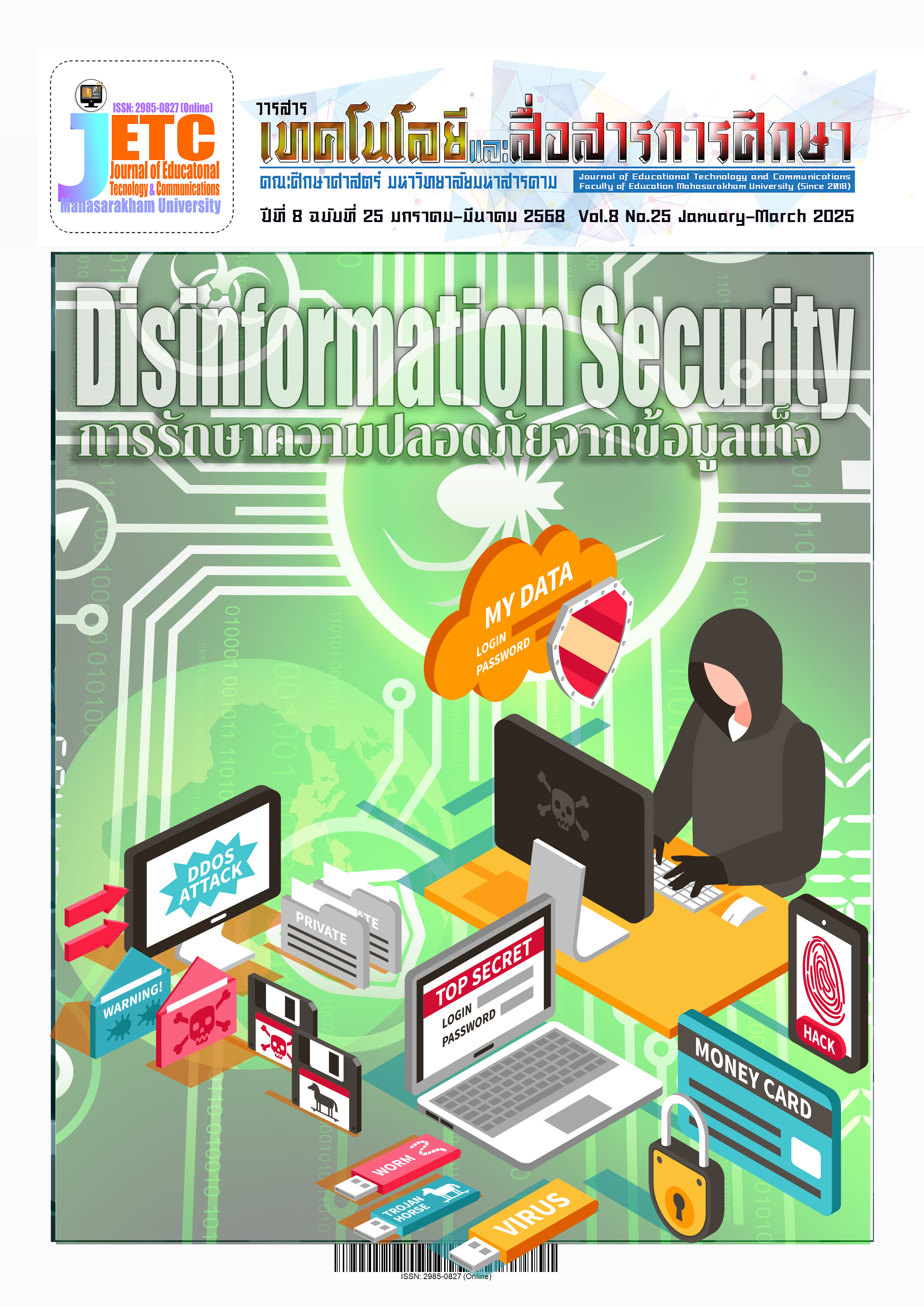Learning Management Using the 4 MAT Teaching Model in History Subject on the Topic of Ancient States in Thailand for Mathayom Suksa 1 Students at Demonstration School of Thepsatri Rajabhat University
Main Article Content
Abstract
The purposes of this research were: 1) compare the learning achievement of students before and after using the 4 MAT instructional model and 2) examine students’ satisfaction after utilizing the 4 MAT instructional model. The sample consisted of 50 students from MathayomSuksa 1/5 enrolled in a history course during the first semester of the 2024 academic year at the Demonstration School of Thepsatri Rajabhat University. The sample was selected through cluster random sampling, with classrooms serving as the unit of sampling. Research instruments included 15 lesson plans, a 30 item academic achievement test, and a 15 item satisfaction questionnaire. Statistical methods employed in the study comprised mean, standard deviation, and t-test analysis for dependent samples.
The research findings were as follows:
1. The comparison of learning achievement demonstrated that students’ post-learning achievement scores (=20.55, S.D.=0.67) were significantly higher than their pre-learning scores (
=17.50, S.D.=0.55) at a significance level of .001.
2. The study of students’ satisfaction with the 4MAT instructional model indicated that the overall satisfaction of Grade 7 students was at the highest level (= 4.71, S.D. = 0.57).
Downloads
Article Details
References
กระทรวงศึกษาธิการ. (2551). หลักสูตรแกนกลางการศึกษาขั้นพื้นฐาน พุทธศักราช 2551. ชุมนุมสหกรณ์การเกษตรแห่งประเทศไทย.
ชัยรัตน์ ตั๋นสกุล, วีระ วงศ์สรรค์ และรสรินทร์ อรอมรรัตน์. (2563). การพัฒนาผลสัมฤทธิ์ทางการเรียนวิชาประวัติศาสตร์ เรื่อง พัฒนาการของอาณาจักรอยุธยา โดยใช้รูปแบบการจัดการเรียนรู้แบบวัฏจักรการเรียนรู้ (4 MAT) สำหรับนักเรียนชั้นมัธยมศึกษาปีที่ 2. วารสารวิจัยธรรมศึกษา, 3(1), 27-35. https://so07.tci-thaijo.org/index.php/dsr/article/view/442
นฤกร แจ้งอรุณ. (2564). การพัฒนาผลสัมฤทธิ์ทางการเรียนวิชาวิทยาศาสตร์โดยวิธีการจัดการเรียนรู้แบบ 4 MAT ของนักเรียนระดับชั้นมัธยมศึกษาปีที่ 2. [วิทยานิพนธ์ปริญญามหาบัณฑิต, มหาวิทยาลัยรังสิต]. https://rsuir-library.rsu.ac.th/bitstream/123456789/1435/1/NARUEKORN%20JANGARUN.pdf
บุญชม ศรีสะอาด. (2560). การวิจัยเบื้องต้น (พิมพ์ครั้งที่ 10). สุวีริยาสาส์น.
ปรียา ถาวีวร. (2564). การพัฒนากิจกรรมการเรียนรู้แบบ 4MAT กลุ่มสาระการเรียนรู้ สังคมศึกษา ศาสนา และวัฒนธรรมสาระภูมิศาสตร์ สำหรับนักเรียนชั้นมัธยมศึกษาปีที่ 5. [วิทยานิพนธ์ปริญญามหาบัณฑิต, มหาวิทยาลัยราชภัฏสกลนคร]. https://gsmis.snru.ac.th/e-thesis/file_att1/2022052060421249128_fulltext.pdf
ล้วน สายยศ และอังคณา สายยศ. (2560). เทคนิคการวิจัยทางการศึกษา. สุวีริยาสาส์น.
วริษฐา เหมชาติวิรุฬห์ และอ้อมธจิต แป้นศรี. (2567). การพัฒนาผลสัมฤทธิ์ทางการเรียน เรื่อง คำภาษาต่างประเทศในภาษาไทยของนักเรียนชั้นมัธยมศึกษาปีที่ 3 ด้วยการจัดการเรียนรู้แบบ 4 MAT ร่วมกับเทคนิค TGT. วารสารมณีเชษฐาราม วัดจอมมณี, 7(3), 84-97. https://so07.tci-thaijo.org/index.php/JMCR/article/view/4758
วิทยา บุญส่งเสริม และอธิคุณ สินธนาปัญญา. (2562). การพัฒนาผลสัมฤทธิ์โดยใช้รูปแบบการสอน 4 MAT ร่วมกับแบบฝึกทักษะ เรื่อง คำไทยที่ยืมจากภาษาอื่นสำหรับนักเรียนชั้นมัธยมศึกษาปีที่ 3 โรงเรียนอักษรพัทยา. วารสารมนุษยศาสตร์และสังคมศาสตร์ มหาวิทยาลัยราชภัฏบ้านสมเด็จเจ้าพระยา, 13(2), 2-19. https://so08.tci-thaijo.org/index.php/jhusocbru/article/view/1605
Bloom B S. (1956). Taxonomy of Educational Objectives, the classification of educational goals–Handbook I: Cognitive Domain. McKay.
Cronbach, L. J. (1970). Essentials of Psychological Test. (5th ed.). Harper Collins.
Morris, S., & McCarthy, B. (1990). 4 MAT in Action II: Sample Lesson Plans for with the 4 MAT System. Excel Barrington, Ill.

